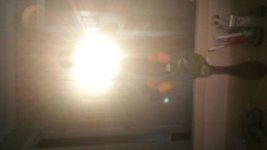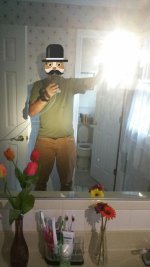All sides have been thoroughly explored. I actually don't like them, but I see why some may find them useful. I would definitely pair one with a handheld, of course.
They're very interesting as a training tool, however. I remember seeing one person at the range with his wife, shooting some polymer 9mm with a green laser. The wife was alright, decent groups at 7 yards and an acceptable spread at 50 feet, despite her husband practically shouting at her to double-tap the lower target and then hit the upper once ("You have to SHOCK THE BODY and then put one in the head!" over and over and over...).
The husband couldn't hit a damn thing. And with the laser, it was exceedingly obvious why. Despite the modest chambering, every time he squeezed the trigger, his point of aim dipped a solid 12"-18" at 7 yards.
Eventually he gave up, berating the "[expletive] gun" for "shooting low", and that he should really replace it with a [insert expensive manufacturer here].
I would have mentioned the problem he was encountering to him, but he seemed rather unteachable, and besides--if you're good at something, never do it for free.
But anyways...a minor post needs clarification.
For starters, a laser should be set to coincide with the iron sights at a distance great enough that parallax is not visible. 50 feet would be a minimum. You can fine-tune at the range, but that usually won't be necessary if your sights are okay.
There are two ways to "zero" a laser, or realistically, any handgun sighting system (although the second is only commonly applied to lasers).
The first is the usual--the point of impact matches the point of aim, at a given distance. In other words, if you picture a line coming out of the bore, and another line from the sight(s), then the two intersect at a given point. The advantage is that it's easier to make a precise shot at the range, but it's more difficult the further away from that point you get. This method is pretty much the only one anyone uses for iron sights and optics.
For lasers, a common alternative is to zero in parallel with the bore. In other words, if your laser is 2" below the centerline of the bore, you adjust the PoA/PoI so that the impact is 2" above the point of aim. If you picture the centerline of the bore projecting outward, and a line projecting from the laser, then the two lines are parallel and never meet. The advantage is that the PoA/PoI relationship isn't affected by distance until bullet drop comes into play (which is well outside common SD distances). It's slightly more difficult to make a truly precision shot at any given range, but range estimation is removed from the equation.
Truth of the matter is that it really doesn't matter a whole ton. At most distances, the difference between the two is much smaller than the best groups your average shooter can produce under the best conditions.
Also, parallax is related to optics like red dots. Simply, every red dot (no matter what the manufacturer tells you) is subject to a small amount of uncertainty. How much it can be off varies with range, and is related to the sight not being precisely in line with your eye. For more:
Encyclopedia of Bullseye Pistol
JavierLaurido said:
In my opinion, I dont think any light or electronic is needed. If I hear a sound, or see a shadow, no matter if its tall or short, I shoot. Reaction its by far the most important issue. Fire first, think later! Also, shoot until you empty your magazine, its better to be sure. Win the encounter, thats the important thing. Later you will have enough time to think what you did.
Well-played, sir, but you failed to refer to it as a "clip", or for maximum points, a "magazine clip". Therefore, I award you two out of three Internets.








